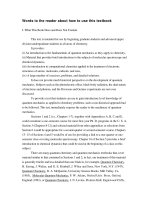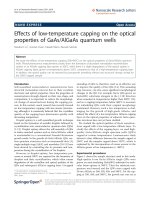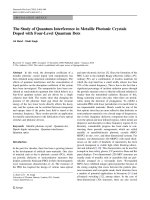- Trang chủ >>
- Khoa Học Tự Nhiên >>
- Vật lý
Schrödingers rabbits; the many worlds of quantum
Bạn đang xem bản rút gọn của tài liệu. Xem và tải ngay bản đầy đủ của tài liệu tại đây (6.54 MB, 283 trang )
www.pdfgrip.com
www.pdfgrip.com
Colin Bruce
Joseph Henry Press
Washington, DC
www.pdfgrip.com
Joseph Henry Press ¥ 500 Fifth Street, N.W. ¥ Washington, D.C. 20001
The Joseph Henry Press, an imprint of the National Academies Press, was created
with the goal of making books on science, technology, and health more widely
available to professionals and the public. Joseph Henry was one of the founders of
the National Academy of Sciences and a leader in early American science.
Library of Congress Cataloging-in-Publication Data
Bruce, Colin.
Schrdingers rabbits : the many worlds of quantum / Colin Bruce.
p. cm.
ISBN 0-309-09051-2 (case)
1. Quantum theoryPopular works. I. Title.
QC174.12.B78 2004
530.12dc22
2004021021
Any opinions, findings, conclusions, or recommendations expressed in this volume
are those of the author and do not necessarily reflect the views of the National
Academy of Sciences or its affiliated institutions.
Cover design by Michele de la Menardiere.
Copyright 2004 by Colin Bruce. All rights reserved.
Hand-drawn illustrations by Laura Dawes from sketches by Colin Bruce.
Printed in the United States of America
www.pdfgrip.com
Dedicated to
Paul Dirac
physicist extraordinary
who believed we must seek visualizable processes
and
Jim Cushing
philosopher of science
who believed we must find local stories
www.pdfgrip.com
www.pdfgrip.com
PREFACE
D
oes the weirdness of quantum indicate that there is a deep
problem with the theory? Some of the greatest minds in physics, including Einstein, have felt that it does. Others prefer to
believe that any conceptual difficulties can be ignored or finessed away.
I would put the choice differently. The flip side of a problem is an
opportunity, and the problems with the old interpretations of quantum present us with valuable opportunities.
First, there is the hope of finding ways to think more clearly about
the subject. I have several times seen highly respected scientists
physicists whose ability to work with the math of quantum mechanics
is certainly better than my ownmake appalling freshman howlers in
describing what the result of an experiment would be, because their
qualitative thinking about such matters as quantum collapse was as
fuzzy as everyone else
s. Better conceptual tools are badly needed
and now they are becoming available.
Second, there is the possibility that a clearer view of quantum will
cause us to see the universe in a fundamentally different way, with
implications both practical and philosophical. Then, as has happened
so many times in physics, the resolution of a seemingly arcane problem will open our eyes to great new wonders. To ignore such an opportunity would be sheer cowardice.
The past few years have seen a sudden explosion of light in the
vii
www.pdfgrip.com
viii
/ Preface
murkier corners of quantum. The old stories, involving such quaint
characters as dead-alive cats and conscious observers with the power
to collapse the whole universe, or even split it in two, are pass
. There
are new stories to choose from, one of them particularly promising. It
restores us to a classical universe where things behave predictably
rather than randomly and where interactions between things are local
rather than long range. But it comes at a price. We must accept that
the universe we inhabit is much vaster than we thought, in an unexpected way.
Although the many-worlds view was invented in the United States,
it is in Europe, and especially in Oxford, that it has developed to maturity. That is my good luck, for I have had the privilege of seeing the
process at first hand. Here I describe the remarkable new picture that
has recently emerged, which I dub the Oxford Interpretation.
My warmest thanks go to my editor Jeff Robbins at Joseph Henry
Press for his vision and determination in ensuring that this book came
to be. Also to many physicists and philosophers at Oxford and elsewhere for valuable advice and discussion, including in particular
Harvey Brown, David Deutsch, Roger Penrose, Simon Saunders, David
Wallace and Anton Zeilinger. Special thanks to Lev Vaidman, Jacob
Foster, and Heather Bradshaw, who read the manuscript at an advanced stage and made many useful comments. Responsibility for any
mistakes that remain, and any controversial opinions expressed herein,
is of course entirely my own.
Colin Bruce
Oxford, 2004
www.pdfgrip.com
CONTENTS
1
2
3
4
5
6
7
8
9
10
11
12
13
14
15
16
A Magical Universe
1
Clinging to the Classical
13
Collapse by Inference
27
A Horror Story Writ Large
40
The Old Testament
57
Lets All Move into Hilbert Space
74
Pick Your Own Universe
92
A Desirable Locality
106
Introducing Many-Worlds
126
Harnessing Many-Worlds 1: Impossible Measurements
140
Harnessing Many-Worlds 2: Impossible Computers
155
Many-Worlds Heroes and Dragons
169
The Terror of Many-Worlds
185
The Classical Warrior: Roger Penrose
198
The New Age Warrior: Anton Zeilinger
211
Proving and Improving Many-Worlds
228
Appendix
251
Notes
253
Index
261
ix
www.pdfgrip.com
www.pdfgrip.com
CHAPTER 1
A MAGICAL UNIVERSE
A
s a teenager, I was a great fan of science fiction and fantasy.
The stories I most enjoyed were those set in a universe very
like our own, but with an extra twistsome magical feature
that made it much more fun to live in than the mundane world I knew.
Then I grew up and discovered something wonderful. Our own real
universe does in fact contain at least one magical feature, a built-in
conjuring trick that seems to violate all the normal rules. Here is a
demonstration.
Imagine that a conjurer of impressive reputation is in town and
one night you go along to his show.
For my next trick, he says, I want a couple from the audience.
To your embarrassment he points straight at you and moments later
you find yourself on stage with your partner.
I would like to give you a chance to get rich, he says, pointing to
a large pile of scratch-off lottery cards, all seemingly identical, and
looking like the one in Figure 1-1.
All you have to do to win a prize, he goes on, is select one of
these cards, and tear it in half between you. Each take your half of the
card and scratch off 1 of the 60 silvered spots on the clock face to
1
www.pdfgrip.com
2 / Schrdingers Rabbits
FIGURE 1-1 Lottery card.
reveal the color, either black or white. If the spots you scratch turn out
to be different colors, you win $500. And it costs only $10 to play!
Of course each of you is allowed to scratch off only one spot on
your respective half of the card. And there is one further rule: To win
the prize, you and your partner must choose spots exactly
one place
apart on the clock face. For example, here is a card that won for two
lucky, lucky people on yesterday
s show. He shows you and the rest of
the audience the card shown in Figure 1-2.
You must allow me some secrets, so I will not tell you exactly
how the cards are colored. But I will tell you this much. Half of all the
FIGURE 1-2 Winning lottery card.
www.pdfgrip.com
A Magical Universe
/3
spots are black, and half white. Also if you and your partner were to
scratch off thesamespot on each clock face, you would always get the
same color both spots would be black, or both white. But if you were
to scratch off spots exactly 90 degrees apart from each other, you would
always get opposite colors; white and black, or black and white.
It seems like a bargain, but you hesitate. How do you know he is
telling the truth? I m from this town, and you
ve got to show me,you
reply, to cheers from the rest of the audience. The conjuror nods,
unsurprised.
Be my guest,he says.You and your partner may choose any
card from the pile, and perform either of those two tests
scratch the
same spot on each half, or spots 90 degrees apart on each half. Do that
as many times as you like. If you prove me a liar,
ll pack
I up my magic
show and take an honest job!
You and your partner duly pull out and test numerous cards. The
results confirm the conjurer
s predictions, as shown in Figure 1-3a
and b.
Is it worth playing the game? You think carefully. First, the left
and right halves of each card must be identically colored
otherwise
you would not be sure of getting the same color every time you scratch
spots in matching positions. Second, there must be at least one place
in each 90-degree arc where the color changes between black and
white. If any card had an arc of more than 90 degrees all one color, you
could sometimes scratch spots 90 degrees apart and get the same color.
The most obvious guessand no doubt what the conjurer intends you to think is that the cards are colored in four quarters, as
shown in Figure 1-4a. There cannot fewer
be segments, as shown in
Figure 1-4b, because then you could scratch spots 90 degrees apart
and get the same color, which never happens. They might be divided
into moresegments, as shown in Figure 1-4c, but that would actually
increase your chances of winning
there are more black-white boundaries to hit.
As you go round the circle, from spot to spot, you take a total of 60
steps. At least 4 of those steps
maybe more, but certainly no fewer
involve a color change, stepping from a black spot to a white one or
vice versa. It follows that the chance of a color change on any particu-
www.pdfgrip.com
4 / Schr dingers Rabbits
FIGURE 1-3a Corresponding spots scratched: colors always the same.
FIGURE 1-3b Spots 90 degrees apart scratched: colors always opposite.
lar step is at least 1 in 15. At those odds, it is certainly worth risking
$10 to win $500, and you accept the bet and select a card. The conjurer
beams.
To make the game a little more dramatic, I will ask you to tear
the card in two between you, and each take your half into one of the
curtained booths at the back of the stage.
He points to two curtained
cubicles rather like photo booths.
Each of you should scratch a spot
of your choice, then stand and hold the card above your head. After a
few seconds the curtains will be whisked away, and you and the audience will see immediately whether you have won. Of course, you can
www.pdfgrip.com
A Magical Universe
/5
FIGURE 1-4a Could the cards be printed in this pattern, alternating quarters black
and white?
FIGURE 1-4b Or this pattern, alternating halves black and white?
FIGURE 1-4c Or this pattern, many alternating black and white segments?
www.pdfgrip.com
6 / Schr dingers Rabbits
use any strategy you like to decide which spots to scratch. You may
confer in advance, you may decide at random, you can toss coins or
roll dice if you think it will help.
He watches with a smile as you and your partner choose a card,
tear it apart, and depart to your respective booths. You have in fact
decided in whispers that you will scratch off spots number 17 and 18,
as measured clockwise from the top. You scratch off your spot and it is
revealed as black. You hold the card above your head as instructed. But
when a moment later a drumroll sounds and the curtains are whisked
aside, the audience sighs in disappointment; your partner
s spot is also
black. You have lost the game.
As you take your seats again, you are not particularly surprised or
disappointed. After all, you reckoned you had only 1 chance in 15 of
winning. But now the conjurer proceeds to call up more of the audience, two by two, and put them through the same procedure, 100
couples in all. Out of the lot, only one couple wins
you would have
expected six or seven. The winning odds appear to be 1 in 100 rather
than 1 in 15, and the conjurer has made a tidy profit. There seems to
have been some mistake in your logic.
You are feeling quite worried. If your reasoning can mislead you
this badly, you are obviously at risk of being cheated right, left, and
center. As the crowd flocks toward the exits at the end of the show, you
are therefore delighted to see your longstanding friend and colleague,
Emeritus Professor Cope. Professor Cope might be old, but he is the
most impressive guy you know. This man has Einstein
s scientific intuition, Poppers philosophical insight, and James Randi
s fraud-busting ability, all combined in one person. He sees your troubled
expression, and smiles.
Don t worry, he says.I m quite sure all is not as it seems.
m I
going to investigate this setup.ll drop
I
by on Monday and tell you
what Ive discovered.
But on Monday, Professor Cope does not look triumphant. He
brushes aside your offer of tea.
The conjurer we saw was not cheating in any obvious way. In
fact, he turns out not really to be a conjurer at all. The only special
thing about him is that he had the luck to come across the supplier of
www.pdfgrip.com
A Magical Universe
/7
these extraordinary cards. I managed to track down this supplier, and
ordered a big batch for myself.
veI been testing them under controlled
conditions, and the results are still exactly the same as you saw at the
show the other night.
Your mouth falls open.But how can that be?you ask.
Professor Cope smiles.
To quote a respected source,
When you
have ruled out the impossible, what remains, however improbable,
must be the truth.The only way to get the results we see is if the two
cards contain some internal mechanism that changes the spot color
depending on circumstances. For there is no fixed coloring that can
explain the results.
But the card halves must also be in some kind of radio contact
with one another. If they operated independently, there is no way the
colors could then always match when you scratch the same place on
each. One card half on its own could not tell whether the other half
had that same spot scratched, or a different one.
So the two halves must be in communication. Each half somehow knows which spot was scratched on the other, hence the angle
between the two spots, and the color revealed on each card is selected
accordingly. It is amazing even in these days of advanced electronic
technology, but each card must include something like a miniaturized
radio transmitter and inks that can change color. I am going to prove
my hypothesis by separating the two halves of a card in such a way
that communication between them is impossible. Then we will see the
mysterious correlation between the two parts vanish. I will tell you the
result next week.
But the following Monday, Professor Cope does not look any
happier.
I tried testing halves of the lottery cards in lead-lined cellars several miles apart, and still got the same disconcerting results. So I borrowed two of those special security cabins-on-stilts used by the
military and diplomats for top-secret conferences inside embassies.
They are designed to allow absolutely no signal of any kind to leak out.
Yet when lottery cards were scratched inside each of them, the results
were still the same.
Then I had a better idea. It occurred to me that there is no such
www.pdfgrip.com
8 / Schr dingers Rabbits
thing as aperfectshield for radio and other waves. So I tore a big batch
of cards in half, and mailed one set of halves to Australia. I also built a
mechanism that allowed a card to be scratched, and the color revealed
to be permanently recorded at an exactly timed instant. The whole
process takes only a fraction of a second. I had my colleague in Australia build a similar apparatus.
We proceeded to scratch cards here and in Australia at exactly
synchronized moments. Now according to Einstein
s theory of relativity, nothing can travel faster than lightneither matter nor radiation
of any kind. As many popular accounts have described, if you could
send a signal faster than light, you could also send one backward in
time.
The distance from here to my colleague
s laboratory in Sydney,
even if you take a shortcut through the center of the Earth, is nearly
8,000 miles. It takes light about a 20th of a second to make the journey, a time just perceptible to human senses. My automatic cardscratching-and-color-measuring apparatus works much faster than
that. So there was absolutely no way that either the card here could
send a signal to its twin in Australia, or the Australian card could send
a signal here, before both cards had to decide what color to reveal.
He pulls a whiskey bottle from his pocket and takes a swig.
I
would have bet my life
s work that under these circumstances, the
strange correlations would disappear. But they did not.
Well, no one is going to call me an intellectual coward. If I have
proved the existence of faster-than-light, backward-in-time signaling
of unlimited range, so be it. One card half must be sending an instantaneous and undetectable signal to the other. There you have it!
You shake your head sadly as you see him out. But the following
evening, he calls in looking much happier.
Forget all that nonsense I was talking yesterday about faster-thanlight signaling, he says.After I left you, I spent some time trying to
figure out how to harness the cards
instant links to transmit information. It would be handy to be able to talk to an astronaut in distant
space without the normal time lag while the radio waves go to and fro,
and even better if you could send a message with tomorrow
s racing
results back in time to yourself! But there is no way to use the cards to
www.pdfgrip.com
A Magical Universe
/9
do these things, because you have no way to influence the color of the
spot you scratch off. It is always 50-50 whether it is black or white. It is
only after you compare the card with its other half that the strange
correlation is revealed.
I decided that because any supposed faster-than-light signaling
mechanism is not available outside the cards
internal workings,
Occams razor that rule of science that demands that one should always seek the simplest explanation, avoiding unverifiable hypotheses required me to dispense with it. I now have a better theory.
The correlations are surprising if you and your partner can make
genuinely free or random decisions as to which spots you are going to
scratch. But suppose those decisions have in fact been preordained for
all time? You feel subjectively that you are freely choosing which spot
to scratch, but actually the movement of the electrons that would make
your neurons fire in that way was inevitable from the start of the universe there is no free will. Similarly, if you use a randomizing device
like dice or a roulette wheel to help you choose the spots, its motion
and outcome were also predictable.
The lottery cards must have been manufactured by an all-knowing alien who simply knew in advance exactly which spot on each half
would be scratched, and printed the cards accordingly. Try as you will,
he has foreseen your every move! This might sound startling, but it
explains away the apparent paradox.
You do not know what to think as Professor Cope takes his leave.
It certainly seems an alarming amount of philosophical baggage to
explain a set of trick lottery cards. At six
clock
o the next morning the
doorbell rings again. You stagger down bleary-eyed in your bathrobe
to find a disheveled but triumphant Professor Cope on the doorstep.
The whiskey bottle protruding from his pocket is nearly empty.
I have it, he says happily.It is amazing how late-night thought,
assisted by strong liquor on an empty stomach, can strengthen
s one
facility for philosophical reasoning. I was worrying about a nonproblem! You would agree that science can concern itself only with
things that are actually observable, rather than mere hypotheticals?
I suppose so,you agree cautiously.
Good! Now, you are a conscious observer and, as such, the only
www.pdfgrip.com
10 / Schr dingers Rabbits
hard data you are entitled to reason about are the things that you have
actually observed. All that precedes observation is mere -thewill-o
wisp, hypothetical, unreal. Let us consider your point of view at the
moment you scratch off the lottery card. You see a color, black or
white perfectly reasonable. A little later you see your partner
s card,
which is also black or whiteperfectly reasonable. The only problem
comes from your worrying about the hypothetical
I wonder what my
partners card was?in advance of actual knowledge, when it was still
an open question. Your partner
s card wasn
t anything until you found
out what it was! When it did become something, it conformed to the
claimed statistics for the admittedly unusual cards. But there is no
problem for physics, as long as you have a formula to calculate the
statistics. And no problem for philosophers, as long as you do not ask
questions that are in fact meaningless because you are confusing
hypotheticals with hard data. So, no problem!
This is all a bit much at 6 a.m.
But isnt that a bit solipsistic?you
ask. I mean, what about my partner
s point of view? Are you really
saying that it was meaningless for her to wonder what color the spot
on my card was until she saw it? Confound
I had
it, seen it, and it was
black, not hypothetical!
Solipsism, schmolipsism,
says Professor Cope crossly.
I have explained things from your point of view, the only one you should legitimately be concerned with.
And he turns on his heel.
It is sad to have witnessed the decline of a once great mind, but
you do not see Professor Cope for some time after that, and gradually
you forget about the matter. After all, you have plenty of practical everyday problems to worry about. Then one day, Cope strides confidently up to you in the shopping mall and grasps you by the arm.
I am sorry about the nonsense I was talking a while back,
he says
immediately. I have given up the philosophizing business, and gone
back to hard physics. I now have a perfectly consistent explanation for
the lottery cards that does not involve dubious philosophical assumptions, backward-in-time signals, or any other rubbish of that kind. Let
me buy you lunch. In fact, in a sense I will buy you
lot of
a lunches.
He steers you into a nearby restaurant, and laughs inordinately
when the host asks how many in your party.
Just two, he finally gets
www.pdfgrip.com
A Magical Universe
/ 11
out, that is, as far as
you are concerned, young man.
As you start on
the soup, he launches into his new story.
Like all conjuring tricks, it is quite simple when you see how it is
done, he says.The truth is, the maker of the lottery cards had a rather
special kind of duplicating machine.
Well, I suppose it takes something a bit fancier than a standard
printing press to make those scratch-off cardsyou say, but break
off, because Cope is shaking his head vigorously.
I am talking about something rather grander than that. Those
lottery cards were manufactured by an all-seeing and all-powerful
alien who can duplicate multiple versions of the universe at will!
At the point where two people scratch off spots on the two separated halves of one of his lottery cards, the alien simply multiplies up
the numbers of versions of reality to produce statistics that will conform to his rules. Thus if you each scratch off a spot in the same place,
he creates two versions of the universe. In one, you and your partner
both hold a black spot; in the other you both hold a white. From your
point of view that is to say, from the point of view of any one version
of you the spot color is entirely random and unpredictable, yet you
will always find that it is the same as your partner
s.
If you scratch off spots 90 degrees apart, the alien again creates
two versions of the universe, but this time in one version you hold a
black spot and your partner a white; in the other you hold a white spot
and your partner a black. Again, from any individual
s viewpoint the
color of their spot is unpredictable, but it will always be the opposite
of their partners.
Now for the clever bit. If you scratch off spots exactly one place
apart, the alien creates 200 versions of the universe. In one of those,
you hold a black spot and your partner a white. In 99, you and your
partner both have black spots. In another 99, you both hold white
spots. And in a final one, you hold a white spot and your partner a
black. Again, you or to be more precise in my language, anyverone
sionof you experience getting a spot of entirely unpredictable color,
but then find that your partner holds the opposite color just 1 percent
of the time. He beams proudly.A beautifully simple idea, is it not?
But you have already picked up your coat. There are limits to the
www.pdfgrip.com
12 / Schr dingers Rabbits
nonsense you will listen to, even in return for a free lunch. You have
decided that the best way to retain your sanity is to try and forget the
whole business.
In real life, we cannot escape the challenge so easily. As many readers will of course have realized, the apparently extraordinary lottery
cards are merely behaving in the way all
that
the material in our mundane, everyday world does. Very similar effects can be demonstrated
using the simplest particles of which our universe is built, the photon
and the electron, the basic units of light and matter. Measuring the
spin of an electron, or the polarization of a photon
scratching its
lottery card, so to speakseemingly has an instantaneous effect on
the outcome of a measurement of another particle some distance away.
The formal name for this puzzle is the EPR paradox, after its originators Einstein, Podolsky, and Rosen. It is the most puzzling feature of
the modern formulation of physics known as quantum theory. For
half a century, attempts by physicists and philosophers to explain this
behavior have verged on the bizarre. They are only mildly caricatured
above. The purpose of this book is to find a more commonsense account of how the conjuring trick is done.
www.pdfgrip.com
CHAPTER 2
CLINGING TO THE CLASSICAL
W
hat is the real-life manifestation of the problem that has
gotten scientists in such a spin? It started relatively innocuously about a century ago, with a new twist in an ancient
debateabout whether light was composed of waves or particles.
This question had been considered settled at the end of the 18th
century, through an ingenious experiment by the British natural philosopher Thomas Young, which involved passing light through slits.
When a wave passes through a narrow slit, it tends to spread out on
the other side. You can see this happen when a water wave passes
through the gap in a harbor wall. It does not just continue on its original straight-line track, but spreads out so that all the boats in the harbor end up bobbing up and down. Light behaves in just this way when
it passes through a narrow slit.
Particles dont generally do the same, but its easy to envision how
they could be made to. Suppose you were rolling bowling balls toward
a narrow gap in a fence. It would be easy to place some springy twigs
around the gap so that the bowling balls were deflected by random
angles as they passed through. Then a stream of bowling balls being
rolled toward the gap would spread out over a range of angles on the
far side, just as a wave does. It was evident to Young and others that if
13
www.pdfgrip.com
14 / Schrdingers Rabbits
light consisted of a stream of particles, these might be scattered when
passing close to solid matter (as when passing through a narrow slit)
by something analogous to the springy-twigs effect. So the spreading
is not in itself convincing evidence whether light consists of waves or
particles.
However, a cleverer experiment involving two slits appeared definitive. Imagine a blindfolded man rolling bowling balls toward a
fence in which either or both of two narrow gates might be open. The
gates have springy twigs placed so that any ball passing through a gate
is deflected by a random angle; behind the gates is a line of catchment
trenches into which the balls fall. It is fairly obvious that the effect of
opening both gates is that each trench gets the sum of the balls it would
have gotten if only the left gate was open and those it would have
gotten if only the right gate was open, as shown in Figure 2-1. Certainly, closing a gate can never increase the number of balls going into
a given trench. The bowling balls are of course behaving like particles.
But now suppose we do a similar experiment with waves. For example, we could flood the bowling green and generate water waves of
a particular wavelength, as shown in Figure 2-2. As waves strike the
barrier at the back, water slops over it (more where the waves are
higher, obviously), gradually filling the catchment trenches.
When only one gate is open at a time, the accumulation of water
after an appropriate number of waves have been generated is very similar to the result obtained with the bowling balls, as shown at the top of
Figure 2-2. But when both gates are opened simultaneously, something quite different happens. Now some trenches that got quite a lot
of water when only one gate was open get less, or even none at all.
A little thought reveals why. At points like X, the peak of a wave
from one gate always coincides with the trough of a wave from the
other. (Peaks are shown as solid lines, troughs as dotted lines.) This
leaves the net water depth unchanged at all times, so no water flows
over the barrier. The waves from the two gates are said to cancel at
such points, and this phenomenon is called
interference
. This is behavior that particles cannot possibly exhibit; opening an extra gate never
reduces the quantity of balls reaching any trench. Young realized that
this was a neat way to distinguish waves from particles. When he tried
www.pdfgrip.com









